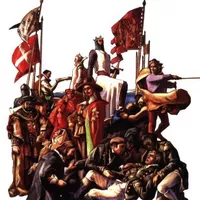CHAPTER CIII. VICTORIA—PEACE
QUEEN VICTORIA'S husband was called the Prince Consort. He was a clever man, and, after he married Queen Victoria, he tried to do all he could for Britain. Although he was German, he learned to speak English almost perfectly, a thing which some of our German Kings had never troubled to do.
The Prince wanted to help trade and to keep peace. So he asked people to come from all parts of the world and bring with them the beautiful and useful things which were made in their countries, and also the things which grew there, such as plants and fruits. These were all to be gathered together in one great building so that the people of each country might see what the people in other countries were doing, and, having seen, might go home with new ideas. In this way the trade of the whole world would be helped. The Prince thought, too, that if people of different countries met together and came to know each other in this friendly manner, they would be less likely to want to fight with each other.
Although we have since had many great Exhibitions or World's Fairs, then, it was quite a new idea. It was so new that many people did not like it. They thought that it would be bad for Britain to bring a number of foreigners there. But in spite of difficulties, the Prince had his way.
One great difficulty was how to make a building quickly enough, and big enough to hold the beautiful things which were to be brought from all over the world. The Prince wanted to have a pretty building, and no one could think of anything except ugly brick sheds.
At last a gentleman, called Sir Joseph Paxton, said, 'Why not use glass and iron?' And he sat down and drew a sketch of what he thought the building ought to be.
This idea of a glass house was quite as new as the idea of having an Exhibition at all, and the Prince was delighted with it. Very soon a palace of glass began to rise in Hyde Park and it seemed so beautiful that the people called it the Crystal Palace.
And very beautiful, indeed, it looked on the opening day. It gleamed and glittered like a fairy thing, it was decorated with the flags of all nations, with palms and flowers, with statues and fountains, and crowded with people from every country in the world.
Queen Victoria opened the Exhibition, and she was glad and happy, both because it all looked so beautiful, and because she knew it was the thought of her husband whom she loved so well. Bands played, a great choir sang, the world seemed full of sunshine and joy.
'And lo! the long laborious miles
Of palace; lo! the giant aisles,
Rich in model and design;
Harvest-tool and husbandry,
Loom and wheel and enginery,
Secrets of the sullen mine,
Steel and gold, and corn and wine,
Fabric rough, or fairy-fine,
Sunny tokens of the Line,
Polar marvels, and a feast
Of wonder, out of West and East,
And shapes and hues of Art divine!
All of beauty, all of use,
That one fair planet can produce,
Brought from under every star,
Blown from over every main,
And mixt, as life is mixt with pain,
The works of peace with works of war.
'O ye, the wise who think, the wise who reign, From growing commerce loose her latest chain,
And let the fair white-wing'd peacemaker fly To happy havens under all the sky,
And mix the seasons and the golden hours;
Till each man find his own in all men's good, And all men work in noble brotherhood,
Breaking their mailed fleets and armed towers,
And ruling by obeying Nature's powers, And gathering all the fruits of earth and crown'd, with all her flowers.' The Exhibition was a great success. Never before had there been so many people from strange countries gathered together in London. Never before had so many beautiful and curious things been seen all at once. When it was over, the Crystal Palace was not destroyed, but was taken down and built up again at another place. There it has remained ever since, and is still one of the sights of London.
But although people hoped great things from this friendly gathering, their hopes were not fulfilled. Three years later, after a peace of forty years, Britain was again at war.

